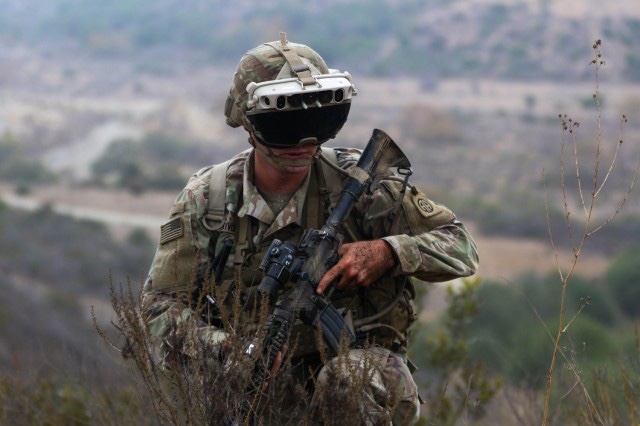
CAMP PENDLETON, Calif. — A thin layer of silver-gray cloud cover rests above an expanse of sloping, taupe-colored hills. The landscape — part of a U.S. military training facility near the southern California coastline — is occupied mostly by shrubs, their amber and green flecks dotting an otherwise neutral terrain.
On the crest of a hill overlooking this stretch of mostly undeveloped land is an abandoned village, or rather, the semblance of an abandoned village. Constructed by the military to provide realistic training opportunities to service members, the collection of structures and nods to everyday life — a carton of eggs for sale, a bicycle discarded along the side of the road — could be representative of any number of locations.
This month, however, the scene is meant to convey an unknown location, somewhere conflict might emerge in the future. It is the setting for a series of mission-based scenarios being conducted through Project Convergence 22, shortened as PC22, an experiment designed to evaluate how the U.S. military can most effectively incorporate new technologies and coordinate with multinational partners to deliver overmatch on future battlefields.
Service members from the U.S., U.K. and Australia are taking part in PC22 experimentation, bringing a wealth of knowledge and resources to simulated and tangible warfighting activities. Included among the thousands of participants are members of the U.S. Army’s 82nd Airborne Division, an elite and rapidly deployable group of airborne infantry Soldiers based out of Fort Bragg, North Carolina.
Known for their ability to parachute into conflict zones, 82nd Airborne Division Soldiers are integral to the U.S. Army and U.S. Air Force’s Immediate Response Force, maintaining the ability to deploy as needed with just 18 hours’ notice. At PC22, they are supporting air assault experiments, dropping from helicopters to traverse unfamiliar landscape with the help of cutting-edge navigational and situational awareness tools.

“We are currently testing out new equipment for the Army,” said Pfc. Nicholas Quintero of the 82nd Airborne Division, who has been participating in PC22 for approximately two weeks.
“We’re going out, we’re doing a lot of training with it and giving feedback,” he explained, highlighting that the goal is to work out kinks and suggest improvements so that the Army can “provide the best piece of equipment for all types of scenarios and situations.”
“It’s a very cool experience,” Quintero said, pointing out that many Soldiers had never handled or even seen the equipment being assessed prior to their participation in the experiment.
In addition to providing materiel developers with candid observations on new equipment, Quintero and other PC22 participants have been able to enhance their understanding of what a future mission might look like, and how new technology is enabling more agile warfighting.
“Right now, intelligence and technology is huge,” said Capt. Dakota Wright. “Being at Project Convergence keeps us at the forefront of military technology.”
“Obviously, it’s going to take time, because technology takes a while, but the concept of this IVAS and the concept of the technology of the future would definitely improve and make the Army a lot more lethal,” Quintero said, referencing Soldier assessments of the Army’s Integrated Visual Augmentation System, or IVAS, prototype.

The event also serves as a training opportunity for Soldiers who may have little to no prior experience on the battlefield.
“We have a real young group of guys out here, so this is a good opportunity for people to get to know each other, learn how to work with each other,” said Sgt. Milton Jean-Baptiste, also of the 82nd, who noted his team is part of the division’s dismounted reconnaissance unit.
Jean-Baptiste stressed the importance of having the Soldiers most likely to use the Army’s new equipment guiding iterative improvements to it.
“At the end of the day, we’re going to be the ones using it. It can be perfect inside of a warehouse or at a table, but we’ll be the ones who have to figure it out,” he said.
Jean-Baptiste also underscored the urgency of U.S. military leaders embracing new technologies, along with the processes necessary to hone them to specific Soldier needs.
“We don’t want to get left behind,” he said. “Seeing that there are programs and leaders who advocate for us to get the latest technology and make sure that it works is important, just so that we’re always a step ahead.”
By Maureena Thompson, Army Futures Command
SGT Daniel Ramos, 22nd Mobile Public Affairs Detachment, contributed to this article

